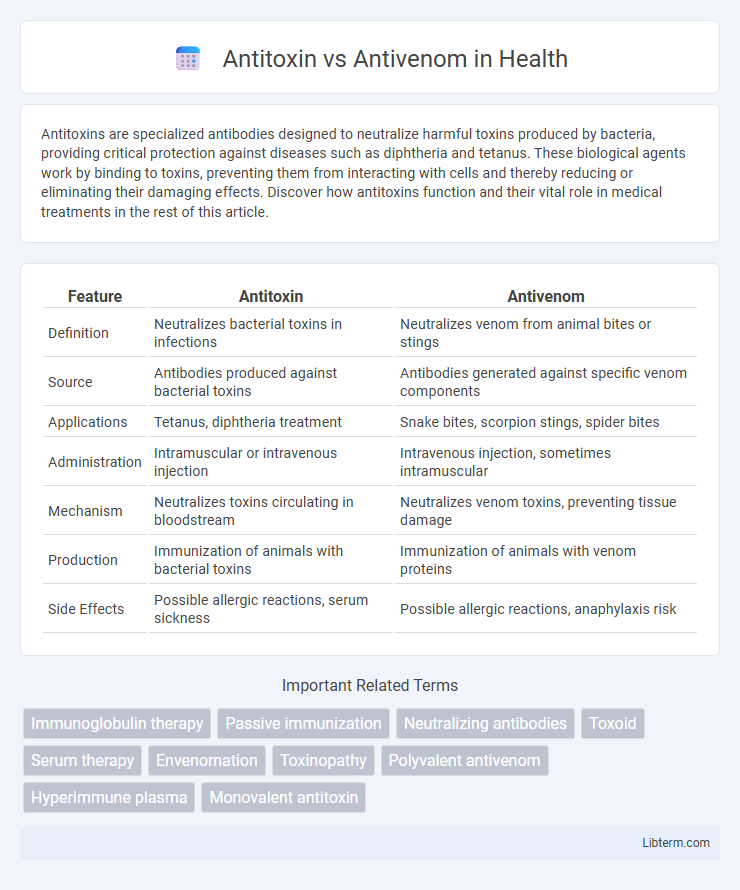Antitoxins are specialized antibodies designed to neutralize harmful toxins produced by bacteria, providing critical protection against diseases such as diphtheria and tetanus. These biological agents work by binding to toxins, preventing them from interacting with cells and thereby reducing or eliminating their damaging effects. Discover how antitoxins function and their vital role in medical treatments in the rest of this article.
Table of Comparison
| Feature | Antitoxin | Antivenom |
|---|---|---|
| Definition | Neutralizes bacterial toxins in infections | Neutralizes venom from animal bites or stings |
| Source | Antibodies produced against bacterial toxins | Antibodies generated against specific venom components |
| Applications | Tetanus, diphtheria treatment | Snake bites, scorpion stings, spider bites |
| Administration | Intramuscular or intravenous injection | Intravenous injection, sometimes intramuscular |
| Mechanism | Neutralizes toxins circulating in bloodstream | Neutralizes venom toxins, preventing tissue damage |
| Production | Immunization of animals with bacterial toxins | Immunization of animals with venom proteins |
| Side Effects | Possible allergic reactions, serum sickness | Possible allergic reactions, anaphylaxis risk |
Understanding Antitoxin: Definition and Function
Antitoxins are antibodies specifically designed to neutralize toxins produced by bacteria, effectively preventing or treating diseases such as tetanus and diphtheria. These substances function by binding to the harmful toxins, rendering them inactive and allowing the immune system to clear them from the body. Unlike antivenoms, which target venom from animal bites or stings, antitoxins address bacterial toxin-related conditions, highlighting their critical role in toxin-mediated disease management.
What is Antivenom? Mechanism and Application
Antivenom is a biological product containing antibodies specifically designed to neutralize venom toxins from snake bites, scorpion stings, or other venomous creatures. Its mechanism involves binding to venom components, preventing their interaction with target tissues and facilitating their clearance from the bloodstream. Antivenom is primarily applied in clinical settings as an emergency treatment to reverse the systemic and local effects of envenomation, significantly reducing morbidity and mortality.
Key Differences Between Antitoxins and Antivenoms
Antitoxins are specific antibodies that neutralize bacterial toxins, while antivenoms are antibodies targeting venom components from animal bites or stings such as snakes, spiders, and scorpions. Antitoxins primarily treat diseases caused by toxins, like diphtheria or tetanus, whereas antivenoms counteract envenomation effects by binding venom proteins to prevent tissue damage and systemic toxicity. The production process differs as antitoxins are often derived from immunized humans or animals against bacterial exotoxins, while antivenoms are produced by immunizing animals with venom and extracting polyclonal antibodies.
Sources and Production of Antitoxin
Antitoxins are produced by immunizing animals, commonly horses or sheep, with specific bacterial toxins to generate antibodies that neutralize these toxins. The harvested antibodies are then purified and processed into antitoxin serum used to treat toxin-mediated diseases such as diphtheria and tetanus. In contrast, antivenoms are derived by immunizing animals with venom from snakes, spiders, or scorpions, highlighting the distinct antigen sources and production processes between antitoxins and antivenoms.
How Antivenom is Developed
Antivenom is developed by first extracting venom from specific poisonous animals such as snakes, spiders, or scorpions, then injecting small, controlled amounts into host animals like horses or sheep to stimulate antibody production. These antibodies are harvested, purified, and formulated into antivenom used to neutralize venom toxins during envenomation. This process relies on the immune response to venom proteins, making antivenom highly specific to the venom of the targeted species.
Common Uses of Antitoxins in Medicine
Antitoxins are primarily used in medicine to neutralize specific bacterial toxins, such as those produced by Clostridium tetani (tetanus), Corynebacterium diphtheriae (diphtheria), and Clostridium botulinum (botulism). These antibodies are critical in treating toxin-mediated diseases by preventing the toxins from damaging tissues and organs. Unlike antivenoms, which target venom from animal bites and stings, antitoxins specifically counteract harmful bacterial exotoxins to reduce morbidity and mortality in affected patients.
Clinical Applications for Antivenoms
Antivenoms are clinically essential for neutralizing venom toxins from snakebites, scorpion stings, and spider envenomations, thereby preventing systemic toxicity and local tissue damage. They are specifically produced by immunizing host animals with venom, resulting in antibodies that target venom components and facilitate toxin clearance. Timely administration of antivenom drastically reduces morbidity and mortality rates, making it a critical treatment in emergency toxicology and rural healthcare settings.
Administration and Effectiveness: Antitoxin vs Antivenom
Antitoxins are administered intravenously to neutralize specific bacterial toxins, commonly used in cases like diphtheria or tetanus, providing rapid systemic toxin neutralization. Antivenoms, also given intravenously or intramuscularly, target venom components from snake bites or insect stings, with effectiveness dependent on timely administration and venom type. The success of both treatments relies heavily on prompt administration; antitoxins generally act faster in neutralizing circulating toxins, while antivenoms require precise matching to the venom for optimal efficacy.
Safety Concerns and Side Effects
Antitoxins and antivenoms both neutralize toxins but differ in composition and safety profiles; antitoxins target bacterial toxins, while antivenoms counteract venom from snakes, spiders, or scorpions. Safety concerns for antitoxins include allergic reactions and serum sickness due to their heterologous protein sources, whereas antivenoms carry risks of anaphylaxis and delayed hypersensitivity reactions. Careful patient monitoring and pre-administration allergy testing are critical to minimize side effects and ensure safe therapeutic outcomes.
Future Developments in Antitoxin and Antivenom Therapy
Future developments in antitoxin and antivenom therapy emphasize improving specificity and reducing adverse reactions through advanced recombinant DNA technology and monoclonal antibody production. Nanotechnology-based delivery systems are being explored to enhance the bioavailability and targeted action of these therapies. Ongoing research aims to develop broad-spectrum antivenoms capable of neutralizing multiple toxins, significantly improving efficacy in treating envenomations and toxin exposure.
Antitoxin Infographic

 libterm.com
libterm.com